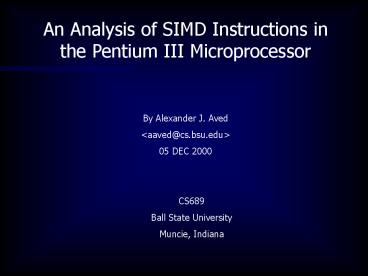An Analysis of SIMD Instructions in the Pentium III Microprocessor
Title:
An Analysis of SIMD Instructions in the Pentium III Microprocessor
Description:
CPU-intensive applications. Integer SIMD/floating point problem ... speed to other computers, or if the CPU is a bottleneck for the performance of the software. ... –
Number of Views:54
Avg rating:3.0/5.0
Title: An Analysis of SIMD Instructions in the Pentium III Microprocessor
1
An Analysis of SIMD Instructions in the Pentium
III Microprocessor
By Alexander J. Aved ltaaved_at_cs.bsu.edugt 05 DEC
2000
CS689 Ball State University Muncie, Indiana
2
TOC
- Problem Description
- Problem Statement
- Research Objectives
- Literature Review
- Importance
- Research Design
- Data Analysis
- Schedule
- Facilities
- Deliverables
- Summary
3
Problem Description
The Intel Pentium III microprocessor has 70 new
instructions, many of which are SIMD
instructions, among other enhancements over the
Pentium II. The cost of producing a new
microprocessor is very high, and if the benefits
of using the latest processor are marginal, Intel
will need a way to get people to buy it.
4
Problem Statement
In my research I will determine if the Pentium
IIIs SIMD instructions offer a performance
increase that is noticeable to the typical home
computer user, or if the functionality provided
by the SIMD instructions are of little benefit to
the typical home computer user.
5
Problem Statement (Cont)
- Sub-problems
- What software is included in a home computer?
- Which software benefits from SIMD instructions?
6
Problem Statement (Cont)
- Delimitations
- Limit software to pre-installed software from
computer vender - I will choose 15 computers to analyze (10
desktops and 5 laptops), 2,000-2,500 price
range - All will be configured with Windows 98 Second
Edition
7
Research Objectives
The objective of my research is to determine if
the SIMD instructions in the Pentium III
microprocessor actually facilitate an increase in
performance that is relevant to the average home
computer user, or are the performance gains
provided by the SIMD instructions insubstantial.
8
Literature Review
- Overview of Intel 32-bit ISA
- Overview of SIMD instructions in Pentium III
- Some applications of SIMD instructions
- Some non applications of SIMD instructions
- Current research trends in this area
9
Literature Review (Cont)
- 32-bit Dynamic Execution Architecture
- Out-of-order execution
- Superscalar
- Pipelined
- Branch Prediction
10
Literature Review (Cont)
- SIMD Instructions in the Pentium III
- MMX Multi-Media eXtensions (57 Instructions,
1997) - Mapped 64-bit MMX registers onto 80-bit
floating-point registers - Streaming SIMD Extensions (SSE)
- 8 new 128-bit registers added
- I use the term SIMD to include SSE and MMX
instructions
11
Literature Review (Cont)
- Applications of SIMD
- DSP
- Fast Fourier- and Inverse Discrete Cosine
transformations (used in MPEG and JPEG,
respectively) - Many more (fluid dynamics, weather modeling, VLSI
circuit routing, etc.)
12
Literature Review (Cont)
- Non-Applications/problems with SIMD Instructions
- A high degree of data parallelism is needed
- CPU-intensive applications
- Integer SIMD/floating point problem
- OS support needed (context switch)
13
Literature Review (Cont)
- Current trends in this area
- Current trends may be grouped into three major
categories - Make SIMD machines behave like MIMD machines
- Scientific applications of SIMD (fluid dynamics,
computer vision, etc.) - Investigation of SIMD instructions in non-SIMD
microprocessors with respect DSP and image
compression - My research is a totally new approach
14
Importance
The goal of this research is to show that the
SIMD instructions in the Pentium III, by
themselves, do not significantly enhance the
computing experience of home computer users. With
the results of this research someone in the
market for a home computer can make a more
educated decision as to whether or not they need
a computer with a microprocessor that includes
SSE in its ISA.
15
Research Design
- The software will be categorized by type
- Word Processing/Page Layout (PageMaker)
- Data Entry (MS Money)
- Data Lookup (an encyclopedia)
- Spreadsheet (Excel)
- Web Browsers (Netscape)
- Educational/Tutorial
- Media Players (Real Audio player)
- Other/Miscelaneous
16
Research Design (Cont)
The software will be subcategorized based upon
inherent data parallelism, dependence on
connection speed to other computers, or if the
CPU is a bottleneck for the performance of the
software. Of the software that has data that
exhibits significant parallelism to warrant the
use of SIMD instructions, the VTune Performance
Analyzer will be used to determine if the product
actually uses any SIMD instructions.
17
TOC
- Problem Description
- Problem Statement
- Research Objectives
- Literature Review
- Importance
- Research Design
- Data Analysis
- Schedule
- Facilities
- Deliverables
- Summary
18
Data Analysis
This research is a qualitative analysis of the
benefits of the SIMD instructions to home
computer users. My data analysis section will
consist of a table showing which software
products have data that exhibit significant
parallelism to benefit from SIMD instructions,
the software that currently uses SIMD
instructions and the software that would has no
need for SIMD instructions due to the
asynchronous nature of its data.
19
Schedule
Planned project duration 11 months Month 1
obtain computer equipment and software Months 2
through 9 perform analysis as previously
described Month 10 create final report Month
11 present findings
20
Facilities
- An Internet connection (56.6K would be adequate)
- VTune Version 4.0 (from Intel)
- Fifteen computers (10 desktop, 5 laptop)
(including software)
21
Deliverables
Research Report
22
Summary
I plan to show that the Intel Pentium III
microprocessor incorporates SIMD instructions
that are very useful for scientific applications,
but are of limited use in the home computing
environment. References available at
http//www.cs.bsu.edu/aaved/Research_Proposal.doc
Presentation available at http//www.cs.bsu.edu/
aaved/Presentation.ppt
23
Questions?
Questions?































